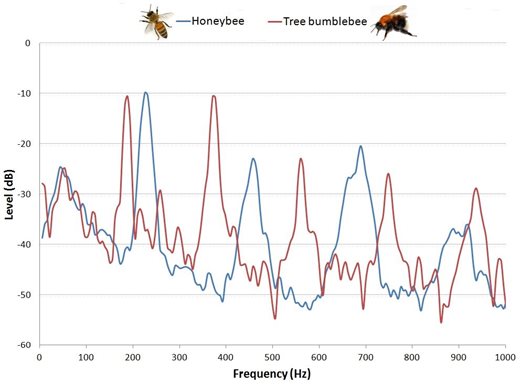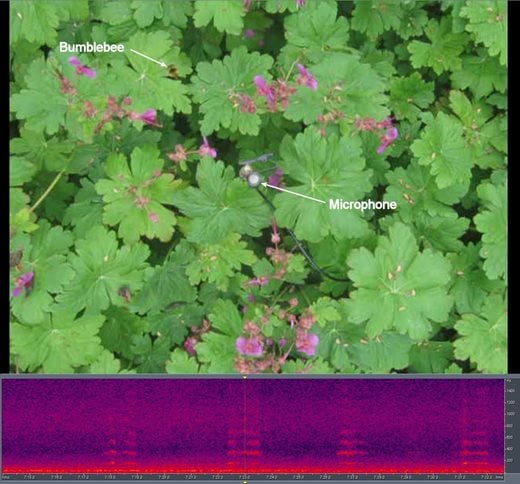Richard Beason, soundscape ecology PhD student with the NERC DTP at Royal Holloway, gives us an insight into novel bee recording methods in this guest blog
Pollinating insects are essential to the life-cycles of many plant species and provide invaluable
ecosystem services to agriculture. The reported
decline of pollinator populations around the world could have serious implications for the health of natural ecosystems and human food production. Experiments assessing ways in which we can provide the best resources to give our pollinators a helping hand, such as
Plants for Bugs here at Wisley, are therefore very important.
In order to gain useful information from such experiments it is obviously necessary to record the number and species of visiting pollinators. Although the Plants for Bugs experiment uses harmless, observational methods to record pollinators, other studies have employed survey techniques that involve killing any visiting insects in order to identify them later1.
1 As a student of
soundscape ecology, I wanted to investigate the possibility of using acoustic monitoring as an alternative method of performing pollinator species counts and identification without having to harm any of them.
You may have noticed how the buzzing noises made by bumblebees, wasps and flies sound different to one another. This is because the buzzing sounds made by flying insects are dependant upon the rate at which they beat their wings, thus determining the frequency (or pitch) of the sound they produce
2. Theoretically, as different flying insects beat their wings at different speeds, it should be possible to identify them based on the frequency of the buzzing sound they typically make. Indeed, a recent publication
3 has demonstrated it is possible to identify different species of bumblebee acoustically, using only audio recordings of their buzzing.
Flying free
 Image, right: - Comparative frequency analyses of the buzzing sound of a European honeybee (Apis mellifera) and a tree bumblebee (Bombus hypnorum) - click to enlarge.
Image, right: - Comparative frequency analyses of the buzzing sound of a European honeybee (Apis mellifera) and a tree bumblebee (Bombus hypnorum) - click to enlarge.
Although measurements of the different frequencies produced by bees, wasps and hoverflies have been performed, historically many of these used tethering as a means of recording the insect under laboratory conditions. This involves attaching the insect to a pin or piece of wire so that it can't fly freely, a method which seemed quite unnatural to me. My study therefore aims to record pollinators under more natural circumstances, in free flight as they visit plants of their own accord, by placing microphones in plant beds and recording any species that happen to visit.
Survey beds are simultaneously recorded with a video camera so that both visual and audio records of each survey are obtained. Synchronising these recordings subsequently provides a way of visually validating results obtained by acoustic identification methods and also gives some indication of the effective range over which visiting insects can be detected.
I mage right:- video of a bumblebee combined with a spectrogram of the simultaneously recorded audio file. Wavy lines in the spectrogram represent the buzzing of bees visiting the flower bed - click to enlarge.
mage right:- video of a bumblebee combined with a spectrogram of the simultaneously recorded audio file. Wavy lines in the spectrogram represent the buzzing of bees visiting the flower bed - click to enlarge.
Richard Beason
References
1. Lowenstein, D.M., Matteson, K.C., Xiao, I., Silva, A.M. and Minor, E.S. (2014) Humans, bees, and pollination services in the city: the case of Chicago, IL (USA). Biodiversity and conservation, 23(11), pp.2857-2874.
2. Dudley, R. (2002) The biomechanics of insect flight: form, function, evolution. New Jersey: Princeton University Press.
3. Gradišek, A., Slapničar, G., Šorn, J., Luštrek, M., Gams, M. and Grad, J. (2016) Predicting species identity of bumblebees through analysis of flight buzzing sounds. Bioacoustics, pp.1-14.

